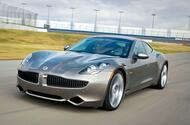We look at the recently-bankrupted firm and its turbulent history, from pretty GT cars to the iconic Karma saloon
Nascent electric car maker Fisker has gone bankrupt. That’s a headline from last month – and from a decade ago - because its eponymous founder has suffered the exact same fate twice over.
Danish-born Henrik Fisker landed his first design job in 1989 at BMW, where his first creation was, fittingly, the E1 EV concept. He then worked on the Z8 and X5 before joining Aston Martin, where he collaborated with Ian Callum on the DB9 and Vantage, then had a brief stint at Ford and bravely went freelance in 2005.
His new California-based Fisker Coachbuild firm stepped out later that year with the Tramonto and Latigo: a rebodied Mercedes-Benz SL 55 AMG roadster with a grille inspired by the F-22 fighter jet and a rebodied BMW 640Ci inspired by the iconic 3.0 CSL of the 1970s.
“Why will we succeed? Because there is a demand for exclusivity,†Fisker told us. “All we are looking for is 150 people to buy a unique car, a car based on proven, reliable technology, a car that’s elegant to look at and exciting to drive.â€
‘Unique’ proved an unfortunate choice of word, because the Latigo never made production, while only 17 Tramontos rolled off the line. A Latigo CS emerged in 2007 with the M6’s V10, but that would also be the sole example of its type.
Around this time, Fisker had also been working for two start-ups: one aiming to make sports cars in Germany, the other to popularise and democratise EVs globally.
Emerging in 2007, Artega’s pretty GT, a Porsche Cayman rival, had an aluminium spaceframe and Volkswagen's VR6. We found it “good enough to justify serious considerationâ€, but Artega ran out of money after only 153 examples had been produced.
Meanwhile, Tesla began a legal battle over its Model S saloon EV (which was still five years away from being ready), alleging that Fisker had deliberately penned a poor design and stolen its work for his own electric saloon, the Karma.
Happily for Fisker, a judge ruled that he had clearly done nothing wrong and made Tesla pay him $1m – not that he really needed it, being well on his way to raising $1bn from investors (movie star Leonardo DiCaprio among them).
Making 398bhp and a staggering 981lb ft yet being cleaner than a Toyota Prius, Fisker’s uniquely styled, aluminium-spaceframed saloon had two electric motors at the rear, fed by a 20kWh lithium ion battery that yielded 50 miles of range before an ex-Pontiac 2.0-litre four started turning petrol to electricity for another 250 miles.
The large amount of new tech it contained led to the Karma being plagued by delays, but eventually, in 2011, it replaced the Cayman and Boxster at Finnish contract manufacturer Valmet’s factory.
Its price was around $100k, way over the initial target of $80k, but still Fisker felt 100,000 sales by 2015 were achievable across three bodystyles: the saloon, Sunset cabriolet and Surf hatchback.
Our first review read: “Serious drivers, look away now. But let’s say you live outside London but work in the City. You want a car of timeless elegance and outstanding efficiency to soothe you there and back. There would be no better weapon for this journey.â€
Celebrities also really took to the car, including DiCaprio, US politicians Al Gore and Colin Powell, musicians CeeLo Green, Justin Bieber and Carlos Santana and several sport stars.
A bullish Fisker unveiled a larger REx saloon, the Atlantic, in 2012, but disaster struck before it could come to fruition, as the firm’s sole battery supplier, A123 Systems, filed for bankruptcy after having to issue two recalls (among several for the Karma).
Only about 2450 examples had been built up until then – 338 of which had been written off when Hurricane Sandy caused flash flooding while they were waiting at New Jersey port.
Fisker resigned the following March over “disagreements over business strategyâ€. By November the firm was bankrupt, with $139m of a $192m US government loan unpaid.Â
It wasn’t short of suitors: ex-GM boss Bob Lutz, BAIC, Geely and Wanxiang among them. It was the last of those that prevailed, having already saved A123, and in 2016 started selling the revised Karma Revero. Fisker instead set up a new eponymous EV maker – but you know how that’s going.

